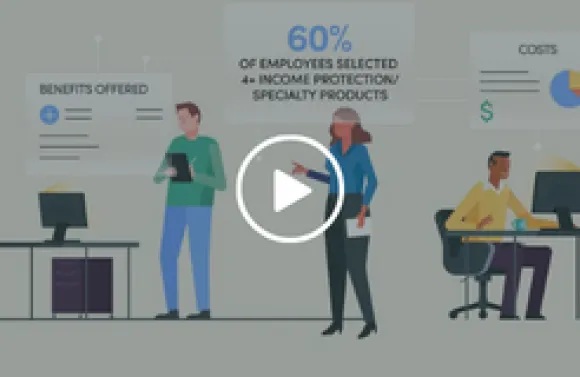
There has been so much written about tailoring employee benefits based on the generations that make up a workforce population. But everyone is living life at their own pace. For example, a generalization is made that Millennials are waiting until later in life to get married or have kids. But that doesn't mean they all are waiting until their mid thirties. Similarly, depending on your profession or circumstance, you may enter the workforce at a much later time than someone that goes in right after college.
The point is, you can't just generalize based on age any more. To design an attractive, competitive benefits offering, it's important to consider what employees may need at each of the different stages of life they experience.
Let's look at some hypothetical examples of employees at each life stage to identify considerations beyond simply age, gender or income:
Stage 1: Starting Out
Meet Savannah. Savannah graduated with a bachelor's degree debt-free. However, instead of starting a career in her major, she decided to travel for a couple of years using money her late grandmother had left her. She worked temporary jobs here and there, staying covered on her parent's health plan.
When her travels came to an end, Savannah decided to get her graduate degree and settle into a full-time job she was passionate about. But this time, she would come out with $20,000 in student loans to pay back.
What types of benefits might attract someone like Savannah as she starts out in her first full-time job at approximately age 26?
With 40 percent of all student loan debt used to finance graduate and professional degrees¹, offering student loan refinancing or reimbursement could give employers that require this level of education a competitive advantage for both attracting and retaining employees. Also, offering a health advocacy service can help first-time health plan enrollees like Savannah more easily navigate the health care system and understand how to use her benefits.
Stage 2: Planting Roots
Meet Dave. Dave just got married to his wife, Mary, who has three dogs. Both in their mid-30s with stable jobs, Dave and Mary are looking to buy a home together. The first-time home buyers soon realize they need an attorney to help them navigate the process. Meanwhile, due to their breed, Mary's dogs are susceptible to certain chronic conditions, which can lead to frequent vet visits as they age.
What types of benefits might an employer want to highlight to attract or retain Dave?
Pet insurance or pet discount plans are likely to catch Dave's eye, as he soon learns that health care for three dogs is likely to cost as much as, if not more than, his own health care. And with group legal insurance covering home purchases, that could be a big plus for Dave, too. Legal benefits can also provide coverage and protection for things some people avoid due to cost or frustration, like preparing a will or refinancing a house.
Stage 3: Career Growth
Meet Nora. For someone that's only 39, Nora boasts an impressive résumé, having worked for several fast-growing companies. She's finally married to the man of her dreams, who is 15 years older than her. At this point in their careers, the couple agrees that having kids would be too much for their busy lifestyle. But Nora and her husband have just learned that they'll need to relocate to help his aging mother take care of his chronically ill father. This makes Nora realize that, without any kids, she and her husband need to figure out their own plan for how they'll take care of themselves later in life.
What types of benefits could be the difference maker for the highly-recruited Nora as she chooses between jobs in her new location?
Long-term care is certainly a benefit that could interest someone like Nora, who's approaching 40 and will likely not only be responsible for taking care of herself later in life, but also could be taking care of her older husband before she retires. According to the U.S. Department of Health and Human Services, more than 70 percent of Americans over the age of 65 will require long-term care insurance at some point.²
Additionally, with Nora's busy, on-the-go lifestyle, anything that's going to save her time will also be of value to her. Benefit offerings like grocery delivery or on-demand exercise apps could help an employer stand out to a candidate like Nora.
Stage 4: Approaching Retirement
Meet Dean. Dean is in his mid-50s with a son that will be entering college at the time Dean retires. Dean has built retirement savings, but he wants to be sure he's accounting for the cost of his son's education, as well as protecting his family if anything unexpected were to happen.
What types of benefits could Dean's employer offer to give him and his family peace of mind?
A 529 savings plan is sure to entice anyone with a child that's planning to attend college, no matter where they are in life. There are also college planning tools employers can offer for parents who want to stay involved and keep their child focused on their future during the years leading up to college.
Several benefits we've already mentioned would also be on Dean's radar, including legal insurance and long-term care insurance. One additional benefit that's becoming more popular for all stages of life in today's digital world is identity theft protection, which could provide peace of mind for Dean that his retirement plans and savings are safe.
As you can see, there are benefits that can apply across multiple types of lifestyles. One type of benefit that you can count on to be appealing to most people is property insurance. Whether it's a home or a car, leased or purchased, most people are required to have some type of property coverage. Making property insurance part of an employer benefits package can provide the additional competitive edge companies are looking to achieve in today's war for top talent.
Check out the latest Benefitplace Benefit Catalog to find out what in-demand benefits you can make available to your workforce—without adding administrative burden!
1 Student Loan Debt Statistics
2 2018 U.S Department of Health and Human Services



